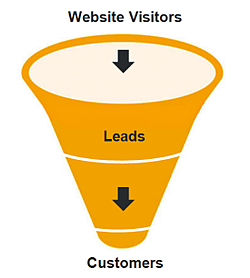
There's only one problem. All that traffic to your site isn't leading to any new business! People are visiting your site, but those visits aren't leading to new customers -- or even new sales leads.
Our Online Marketing Suggestions before thinking on converting website traffic into leads you should first have already launched your blog, optimized your site for search engines, and started participating and promoting you content via social media. After several weeks executing all those previous activities your should start to see a spike in your website traffic.
Good job! Now let's see how to create your B2B lead generation strategy to convert those new visitors into potencial customers.
So what do you do?
Simple. Focus on conversion. Focus on converting more of your website traffic into sales leads. To do this, decide on a compelling offer for your customers, create a call- to-action to promote your offer, and launch a landing page with a form for visitors to submit their information to obtain the offer. Finally, test, measure, and iterate the whole process.
Here's a detailed guide to each step in this sales and marketing conversion funnel:
Step 1: Decide on Your Offer
 The offer is the most important part of any campaign. It's the initial attraction that catches the attention of your website visitors and gives them a reason to fill out the form used to collect their information. Your offer should target the type of sales lead you’re trying to attract. For example, if you're a golf instructor, you want to create offers that will appeal to golfers trying to improve their game. If you're a sales process consultant, you'll want to create offers that appeal to executives trying to improve their sales process.
The offer is the most important part of any campaign. It's the initial attraction that catches the attention of your website visitors and gives them a reason to fill out the form used to collect their information. Your offer should target the type of sales lead you’re trying to attract. For example, if you're a golf instructor, you want to create offers that will appeal to golfers trying to improve their game. If you're a sales process consultant, you'll want to create offers that appeal to executives trying to improve their sales process.
Step 2: Create Calls-to-Action

Once you decide on your offer, create a few compelling CTAs. As we alluded to in Step Three of this eBook, a call-to-action is a button or a link on a website that grabs a user’s attention and directs that user to a landing page. On the landing page, the user is prompted to complete a form and submit contact information in order to receive what’s being offered. By submitting that information, the visitor is then converted into a lead with whom your sales team can follow up. Your call-to-action can be text, an image, or html, but it should always include a link to the corresponding landing page. If you have an effective call-to-action, you'll convert a high percentage of your website visitors into leads.
Step 3: Create Landing Pages
 After you create a call-to-action, you need to set up the landing page that it will link to. The landing page is the page where your website visitors arrive after they click on your call-to-action, and where they will fill out the form to receive your offer.
After you create a call-to-action, you need to set up the landing page that it will link to. The landing page is the page where your website visitors arrive after they click on your call-to-action, and where they will fill out the form to receive your offer.
You’d be surprised by how many times we’ve seen calls-to-action that aren’t links. Whether intentional or a matter of forgetfulness, the lack of a link will make it much harder for visitors to find out how to receive the offer, and they’ll likely give up. So double, triple, and quadruple check to make sure all of your CTAs link to their corresponding landing pages.
Step 4: Test, Measure & Iterate
 Offers, calls-to-action and landing pages are the core elements of the conversion process, but you can't stop there. If you just have a single conversion pathway, you have very little insight into the process and the way it performs. In order to improve your conversion process, you need to experiment. You need to test different CTAs, you need to test different landing pages, you need to test different offers, and then you need to decide which ones best help you achieve your goals.
Offers, calls-to-action and landing pages are the core elements of the conversion process, but you can't stop there. If you just have a single conversion pathway, you have very little insight into the process and the way it performs. In order to improve your conversion process, you need to experiment. You need to test different CTAs, you need to test different landing pages, you need to test different offers, and then you need to decide which ones best help you achieve your goals.
Want more simple lead generation ideas?
Take a look at the best strategies for generating sales leads to grow your business, Download Free ebook "Leads Generation Ideas for B2B" full of data-supported strategies for web marketing success.



Comments
Currently, there are no comments. Be the first to post one!